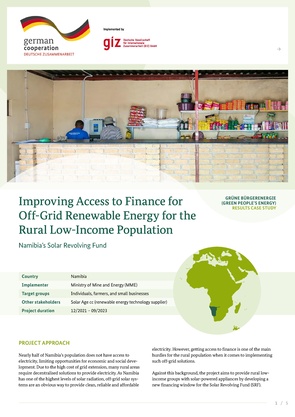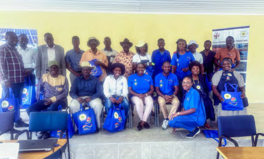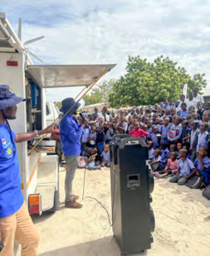Knowledge fuels change - Support energypedia!
For over 10 years, energypedia has been connecting energy experts around the world — helping them share knowledge, learn from each other, and accelerate the global energy transition.
Today, we ask for your support to keep this platform free and accessible to all.
Even a small contribution makes a big difference! If just 10–20% of our 60,000+ monthly visitors donated the equivalent of a cup of coffee — €5 — Energypedia would be fully funded for a whole year.
Is the knowledge you’ve gained through Energypedia this year worth €5 or more?
Your donation keeps the platform running, helps us create new knowledge products, and contributes directly to achieving SDG 7.
Thank you for your support, your donation, big or small, truly matters!
Improving Access to Finance for Off-Grid Renewable Energy in Namibia
Improving Access to Finance for Off-Grid Renewable Energy in Namibia
Project Approach
Nearly half of Namibia’s population does not have access to electricity, limiting opportunities for economic and social development. Due to the high cost of grid extension, many rural areas require decentralised solutions to provide electricity. As Namibia has one of the highest levels of solar radiation, off-grid solar systems are an obvious way to provide clean, reliable and affordable electricity. However, getting access to finance is one of the main hurdles for the rural population when it comes to implementing such off-grid solutions. Against this background, the project aims to provide rural low income groups with solar-powered appliances by developing a new financing window for the Solar Revolving Fund (SRF).The SRF was established in 1996 by MME as a nationwide credit facility to promote the use of solar energy technologies in rural areas, particularly for off-grid communities. The SRF operates on an ownership model where applicants can obtain loans to purchase renewable energy products. Under this model, applicants must first obtain a detailed quotation from an accredited energy service provider for the supply and installation of the technology, and then pay an upfront deposit to secure a loan from MME. This is designed to give borrowers a greater sense of ownership of the solar equipment they purchase.The new financing window introduced by the Green People’s Energy project (Grüne Bürgerenergie, GBE) and MME provides loans to low-income groups to procure solar appliances particularly intended for the productive use of energy (PUE). While the prices of the solar appliances are not subsidised and need to be fully covered by the users, the loan conditions are specifically designed to make the fund accessible to borrowers with limited income. In addition, the financing window includes a supporting digital infrastructure to facilitate and manage the repayments.
The target groups of the new funding window are:
- low-income individuals,
- farmers (with irregular income) and cooperatives, and
- rural traders and small enterprises who are excluded from access to funding through the already existing SRF window because they cannot afford the existing loan conditions. The new funding window aims particularly to increase the number of farmers and businesses applying for funds to finance productive use applications.
The payback period for loans provided through the new window is up to 5 years. Low-income individuals (people earning between 1,000 and 7,000 Namibia-Dollar per month) using the solar equipment for private purposes (private users) will pay no interest and have an upfront deposit of 5 % – 20 %, depending on their individual risk assessment and age. Farmers and small businesses using the solar equipment for productive purposes (productive users) pay 4 % interest and have to make an upfront deposit of 10 % – 30 % of the total cost. The different loan conditions reflect the different financial capabilities of the respective target groups.Since farmers and small businesses use the solar appliances for productive purposes, it is expected that these will generate income, thereby allowing the productive users to pay higher interest than private users.GIZ provides the required funds for the new SRF window and receives reports on the fund use from MME, while MME is responsible for implementing all project-related activities, from conducting project awareness campaigns to collecting the loan repayments.
Methodology of Data Collection
The data for this case study report was collected through a review of project documents and four qualitative interviews with representatives of GIZ, MME, and solar companies. Furthermore, 60 loan recipients were contacted to participate in a quantitative survey, of which 28 responded. Of these, 23 are private users and five are productive users (farmers and small businesses). The case study was conducted between January and June 2023. At that time, some project activities were still ongoing. As a result, the impacts captured are not exhaustive.
Key Findings
Project Achievements
As of June 2023, a total of 84 borrowers have used the SRF window to purchase and install solar appliances, with an average size of 346 Wp for Solar Home Systems (SHS) and 1,052 Wp for PUE appliances (solar water pumps and refrigerators). All SHS and PUE appliances are installed with batteries. 26 of the borrowers are productive users, and the remaining 58 are private users. Of the 28 respondents to the quantitative survey, all five productive users replied that they use their solar appliances frequently (more than five times per week), while 83 % of the private users did the same.For two of the five productive users surveyed, the solar systems have replaced previous electricity supply solutions: one diesel generator and one old solar system. For the remaining three productive users, the solar equipment has provided access to electricity for the first-time. Similarly, 22 % of the private users surveyed have replaced previous solutions for electricity supply with new solar-powered appliances, while 78 % have gained access to electricity for the first-time.Of the five productive users interviewed, three have invested in solar irrigation pumps, one in a solar refrigerator and one in another unspecified productive appliance. The private users use their solar appliances mainly for lighting, charging of mobile phones and radios. Four out of five productive users have reported a decrease in energy costs due to the use of the solar-powered appliances, while one has reported a significant increase in energy costs. Of the private users surveyed, 47 % have reported a decrease in energy costs, 30 % have reported no change and 23 % have reported an increase. Those reporting an increase in energy costs are most likely to be those who have gained access to electricity for the first time and are now paying for a product which they did not have before. Those with no change in energy costs are likely to be those that were using solar systems before.
Intermediate Impact
Interviewees have pointed to a number of positive impacts resulting from the productive use of solar equipment, in particular the following: Solar water pumps allow farmers to reduce crop losses through more frequent irrigation. In addition, agricultural activities can be extended into the dry season, increasing production while reducing the time and cost of previous irrigation solutions. The integration of refrigerators into the day-to-day operations of shops has brought remarkable benefits. Solar refrigeration allows shop owners to extend the shelf life of perishable products, thus reducing spoilage. They can also offer new products to their customers, such as chilled beverages.
However, due to the small sample size of productive users who participated in the quantitative survey, such impacts could hardly be measured in a representative way. Nevertheless, it is worth noting that two of the five productive users surveyed have stated an increase in productivity and one has reported an increase in income. One productive user has reported that he had saved on labour costs as a result of the solar appliance. However, one productive user has also reported a decrease in income, while the remaining three have reported no change. While the quantitative survey did not provide insights into the specific reasons, it is reasonable to assume that energy cost reductions and increased revenues through higher productivity are used up for loan repayment and interests, as long as the credits are not fully paid back.
For private users, solar lighting has contributed to an improved quality of life by allowing them to carry out household tasks and leisure activities even after dark, while avoiding the negative health impacts of solutions such as paraffin lamps. In addition, students are now able to learn and do their homework after dark, thereby improving their learning possibilities. Finally, interviewees have reported that the availability of solar power has paved the way for households to acquire other electrical appliances, such as TVs and radios, for their entertainment and information needs.
Challenges in Project Implementation
On the user side, the quantitative survey shows that 14 % of respondents have cited the high cost of battery replacements as the biggest challenge, and 11 % have stated they could not afford potential repairs and maintenance costs. These issues could be addressed, for instance, by including a credit mechanism for battery replacement in the SRF and by MME hiring a technician to take care of potential repairs in the affected households. In addition, 7 % have said that the electricity provided by their solar device is not enough. With only 4 % of respondents stating that they are dissatisfied with the quality of the solar-powered appliances, this does not appear to be a major issue of concern. On the other hand, it is commendable that the majority of the users (57 %) have not faced any problems with their solar appliances (see figure 1).
Regarding project implementation, interviewees indicated that due to the limited time frame of the project, and a combination of other factors such as limited available human resource and the lengthy application process, all planned funds could not be disbursed during the assigned project period. In fact, only about one third (90,000 EUR) of the planned funds for the new SRF window has been used so far. However, the GBE project addressed the lack of staff within MMW by seconding an intern to further accerelate the implemention process.In addition, the project did not generate as much interest from the target group as originally anticipated. Most of the target beneficiaries live in the last mile remote areas of the country with limited internet access and connectivity. This limited the reach of the project in terms of awareness raising to reach all corners of the 14 regions. In response, the GBE project financed an awareness raising compaign which was implemented by the SRF consisting of pamphlets in local language containing information on the SRF micro-loans which were distributed to all fourteen regional offices in the country. Finally, interviewees have pointed out that the ongoing economic crisis caused by the Covid-19 pandemic also played a role in the project‘s difficulties, further complicating matters and exacerbating pre-existing challenges such as the high cost of battery replacements as well as repair and maintenance costs.
Lessons Learned
An effective approach to increase the likelihood of project success would be for the MME to consider the option of hiring additional staff. This would allow to assure that all allocated funds can be implemented. In addition, it would be beneficial to run further awareness campaigns like social media, national radio broadcasting, and national television, as this could help to raise awareness of the SRF’s funding opportunities and generate more interest from the target group. Particularly, a targeted awareness raising campaign developed with an intentional focus on productive use beneficiaries would accelerate fund uptake from the productive use beneficiaries leading to increased sustainability of the fund. However, this can hardly be implemented by MME alone, since the SRF is already suffering from high costs which would increase even more through additional awareness raising measures.
Furthermore, with only about 30 % of the borrowers being productive users, the new funding window only partially reached it’s primary target group. It seems that the proportion of productive users applying for funding from the SRF has remained low also due to the higher interest rate and the upfront deposit required from this group of beneficiaries. However, since improving financing conditions would mean higher risks for the SRF, it is recommended to first increase awareness raising efforts as indicated above. Finally, digitising the application process could, in principle, contribute to making the SRF more accessible to a broader range of people in the target region, allowing them to apply anytime and anywhere. However, testing such solutions in the scope of the GBE project showed that these are very expensive and complicated to implement due to data security concerns.
Sustainability of the Intervention
27 out of all 28 respondents in the quantitative survey report that their solar appliances are still working (96 %), so technical or other operational problems have not been a significant issue so far. The suppliers of the solar appliances provide a one-year warranty, after which any required repairs need to be paid for by the users. A maintenance manual is provided to the users by the supplier in order to carry out simple maintenance work to ensure the proper functioning of their systems (such as cleaning the solar panels and refilling the water in the batteries). MME conducts field visit follow-ups to ensure that the solar-powered appliances were installed, and are being used properly.Finally, according to MME, the borrowers have started to repay their loans as planned and so far no defaults have been reported, which is a positive indication of their ability and willingness to pay. At the end of the GBE project, MME will continue to operate the SRF, the idea being that the funds provided by GIZ for the new funding window can be reused to provide further credits once they have been paid back by the borrowers. GIZ and MME are currently in the process of defining the details for the further use of these funds, including the question if they will continue to be used solely for low-income groups. However, in order to continue to provide finance to low-income groups on a larger scale, MME intends to secure funding also from other donors.
Conclusion and Outlook
The results show that the provision of loans specifically designed for low-income groups, such as the new window of the Solar Revolving Fund, is generally an appropriate instrument for promoting the purchase of solar appliances in rural communities. In fact, since banks do not offer any comparable loans, the SRF of MME is the only available financing instrument for the targeted low-income group. Although the high proportion of private borrowers indicates that the loan terms are more attractive to private users than to productive users, increasing awareness raising efforts could increase also their use of the fund. All productive users who participated in the quantitative survey stated that their peers had expressed interest in learning about their solar-powered systems and had recommended that they purchase similar solar systems. Two of the five productive users surveyed said that this had resulted in others following their advice and investing in such appliances. Similarly, 87 % of private users have reported that others, such as neighbours and friends, have become interested in the technology and have recommended it to them. 26 % of the private users have reported that their advice has been followed and that their neighbours or friends have also purchased a solar system as a result of their example.
Against this background, it is expected that the results of the project intervention will continue and be further scaled up beyond the completion of the project, paving the way for potential growth and development in rural areas. Despite the difficulties encountered, particularly due to limited awareness-raising activities, the new SRF funding window is a good example of how the challenge of energy access for lowincome groups can be tackled with a high degree of ownership on the political partner’s side.
























